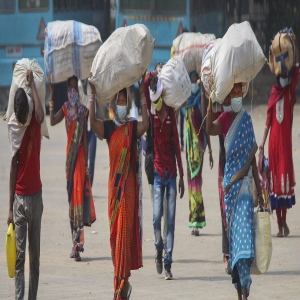

Migration, a spatial process of changing one's residence, is as old as human civilisation itself. This complex and ongoing phenomenon is driven by a multitude of factors, including historical, economic, political, and environmental considerations, which in turn impact citizenship, social environments, and relationships.
A Multiple Indicator Survey reveals that nearly three in every 10 individuals in India were migrants in 2020-21. According to the Migration in India report, based on the Periodic Labour Force Survey (2020-2021), India's migration rate stood at approximately 29% overall, with urban areas witnessing a higher rate of around 35%.
The World Economic Forum Report (2017) notes that India's in-migration is growing at an annual rate of 4.5%. States such as Maharashtra, Delhi, Punjab, and Gujarat have emerged as central hubs for in-migration, attracting a significant number of individuals. Conversely, Kerala, despite being one of India's most developed states in terms of social and educational indicators, has witnessed a substantial number of out-migrants, particularly to West Asian countries.
Internal Migration in India
Post-colonial India experienced its first wave of migration following the partition of British India. It resulted in the forced displacement of approximately 14 million people between India and Pakistan.
The second wave of internal migration was triggered by the rapid growth of trade and industries in port cities like Calcutta, Bombay, and Madras. The demand for unskilled labourers in small and medium-sized industries led to a massive influx of migrants from surrounding rural areas. For instance, the thriving jute industry in Calcutta attracted a large number of workers from Bihar, Odisha, Uttar Pradesh, and Andhra Pradesh. This phenomenon exacerbated regional development disparities, fueling interstate migration.
India's migrants form the backbone of its urban landscape, working as street vendors, construction workers, domestic helpers, gardeners, cooks, and daily labourers who keep urban life running smoothly. They are also the primary breadwinners for rural and small-town India, sending remittances back home to support their families, educate their siblings, and care for elderly relatives.
Socio-Economic Challenges
Migrants in India face numerous exclusionary situations, including social exclusion that encompasses discrimination based on gender, religion, and region, as well as denial of equal opportunities. Those residing in slums are particularly vulnerable, as they rely on the goodwill of local governments, which can evict them without prior notice or alternative arrangements in place. Their lack of political clout and electoral weight makes them more susceptible to exploitation.
Another significant challenge is establishing their identity, as different states have varying document requirements. This makes it difficult for them to open bank accounts without adequate proof. According to Swaminathan A Aiyar, some states, such as Madhya Pradesh, Maharashtra, and Karnataka, reportedly discriminate against migrants, which is unconstitutional (Economic Times, December 23, 2018).
There are also reports of human trafficking, particularly of young women and children, under the guise of migration, as well as instances of sexual harassment. Migrants are often recruited through informal channels, resulting in underpayment and excessive workloads. Cities are ill-equipped to provide guaranteed social protection, resulting in limited access to essential services, including adequate food and nutrition, quality healthcare, housing, water, and sanitation facilities.
Political Challenges
Article 326 of the Indian Constitution grants universal adult franchise to all citizens, provided they are registered in the electoral rolls for parliamentary or assembly constituencies. However, the challenge lies in proving citizenship rights, which are residence-based and require documentary proof of identity.
This situation puts migrants in double jeopardy. Firstly, they are unable to access and avail themselves of social protection schemes and public services. Secondly, as migrants cannot cast their votes outside their place of origin, many are denied their fundamental right to participate in the electoral process.
A study by Amrita Sharma and her co-authors found that 22% of seasonal migrant workers in India lacked voter IDs or were not listed in the voter rolls. Similarly, a study by Aajeevika Bureau (2010-11) in five states – Uttar Pradesh, Bihar, Maharashtra, and Gujarat – revealed that a large number of seasonal migrants were unable to participate in the electoral process, both at their place of origin and at their place of work.
In the 2019 general elections, out of 900 million registered voters, 300 million did not participate. Furthermore, the growing identity politics in some states has also marginalised migrants, as seen in the anti-migrant movement in Mumbai, further exacerbating their exclusion.
The Election Commission of India (ECI) has acknowledged that internal migration is a significant contributor to low voter turnout. Although the ECI explored the idea of discussing the Multi-constituency Prototype Remote Electronic Voting Machine with political parties in early 2023, the matter did not find favour with the government.
The Tata Institute of Social Sciences (TISS) report on electoral participation of domestic migrants highlights the need for reliable data on migrants and the barriers they face in exercising their voting rights away from their place of residence. The report recommends national consultations with political parties to amend Section 20(A) of the Representation of the People (Amendment) Act, 2010, to remove the requirement for physical presence in constituencies to cast votes.
The TISS report suggests that the ECI and political parties consider treating "ordinarily resident" as a multi-local identity for domestic migrants to facilitate voter registration. This would enable migrants to vote from locations where they are not ordinarily residents. Currently, postal ballot facilities are limited to specific groups; extending this facility to migrants could help address their exclusion.
Although the ECI developed a remote voting prototype in January 2023, major political parties backed out. Given the growing agitation against electoral revisions and increasing migrant populations in some states, it is essential to reconsider this issue. Political exclusion of migrants would be a significant democratic deficit for India's democracy.
As India aspires to be a global power, emphasising "sabka saath, sabka vikas" (Together with all, Development for all), migrant exclusion would be a notable contradiction. It is high time for the government to consider framing a robust and comprehensive policy for domestic migrants.